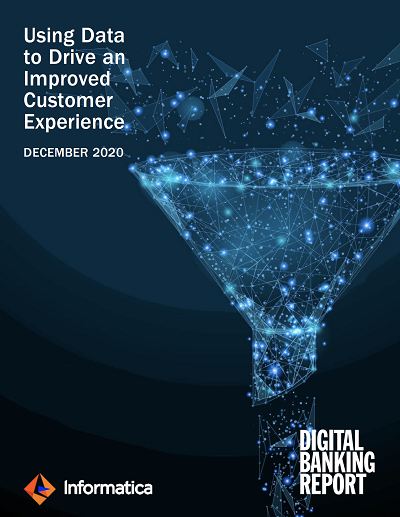Using Data to Drive an Improved Customer Experience
Jim Marous
December 2020
: DBR 273
68 pages, 28 tables/charts
Download Printable Version of this page
Data and advanced analytics are at the foundation of the entire concept of digital banking transformation. As the proliferation of data is growing exponentially, there is an increased need to be savvy and intentional about managing data, and to make sure the quality of data is high and the trust in the data is universal across the organization.
Despite the quantity of data available, much of the available data is underleveraged or used sub-optimally. This comes at a cost to a financial institution, since this insight has the power to drive new sources of revenue, improve operational efficiency, and improve customer experiences.
The goal of data management is to facilitate a holistic view of data and enable users to access and derive optimal value from it. Done successfully, this will lead to measurably better business outcomes, including increased sales, revenue, profit, and customer loyalty. The challenge often is caused by businesses not understanding how to translate the insight they hold into actionable outcomes.
According to our research, most financial institutions use data to meet their business objectives. However, less than half of them trust their data’s quality. There are many reasons for this lack of trust, but this trust deficit must be filled if a bank or credit unions wants to get the most out of their big data, machine learning, or predictive analytics.
Building trust in the data requires discipline and a culture of data governance that actively encourages data accuracy. According to KPMG, the four pillars of a trusted data governance approach include:
- Quality. Is the data reliable enough to build trusted analytics?
- Effectiveness. Does the data and analytics work as intended?
- Integrity. Are analytics being used in an acceptable way?
- Resilience. Are long-term operations optimized?
With data-driven initiatives becoming ever more prevalent and critical to a company’s success, building trust in the data requires an enterprise-wide commitment to seeing that data as an asset – and effectively managing that asset daily.
This report represents the most comprehensive analysis of the use of data for an improved customer experience in the banking industry. This would not have been possible without the support and sponsorship from Informatica, a trusted partner for data solutions to the world’s top companies for over 25 years.
The research provides valuable insights into how financial institutions are using data and analytics to improve the customer experience and the challenges that still exist in deploying data and advanced analytics across organizations.
Using Data to Drive an Improved Customer Experience
Advanced Analytics, AI, Analytics, Artificial Intelligence, Bank, Banking, Big Data, Credit Union, CRM, Customer Experience, Digital Banking, Digital Lending, Digital Marketing, Digital Transformation, Engagement, Fintech, Innovation, Marketing, Mobile Banking, Payments, Personalization, Technology, Trends, Voice Banking, Voice-First

